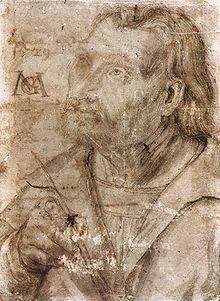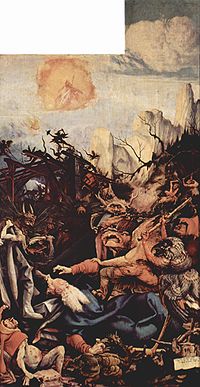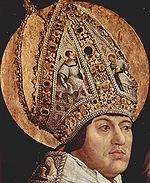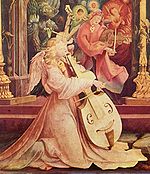.gif)
Mathis der Maler (opera)
Encyclopedia
Mathis der Maler is an opera
by Paul Hindemith
. The libretto
is also by the composer
.
The opera's genesis lay in Hindemith's interest in the Protestant Reformation
. The work's protagonist, Matthias Grünewald
, was an actual historical figure who flourished in that era, and whose art
, in particular the Isenheim Altarpiece
, was an inspiration to many creative figures living in the early 20th century (see, for example, Joris-Karl Huysmans
' novel Là-Bas
).

 Hindemith wrote the libretto
Hindemith wrote the libretto
himself, though at the beginning (around 1932) he had considered working with Gottfried Benn
. The finishing touches were completed in 1935, by which time performances in Germany had become problematic; nevertheless, for several years Hindemith attempted to secure a performance in Nazi Germany, where he was still living until 1938. The action, set during the German Peasants' War
(1524-25), concerns Matthias's struggle for artistic expression in the repressive climate of his day and is clearly a mirror of Hindemith's own life as the Nazis
came to power.
, conducted by Robert Denzler.The British premiere was in Edinburgh
on 29 August 1952, and it was first given in the United States on 17 February 1956, at Boston University, conducted by Sarah Caldwell
.
In contrast to the popular Symphony: Mathis der Maler, the large-scale opera itself is only occasionally staged. A notable US production was that of the New York City Opera
in 1995. Hamburg State Opera staged the work in 2005. It was being performed at the Gran Teatre del Liceu in Barcelona
when the building was destroyed by a fire in January 1994.

is averted only by the arrival of the Cardinal
himself with relics of St. Martin. He promises the merchant Riedinger to countermand an order to burn books, but latter gives in to Pomerfeld who points out that he cannot defy Rome. Mathis, reunited with Reidinger's daughter Ursula, is recognized by Sylvester and makes a passionate plea to Albrecht not to join in the suppression of the peasant's revolt. Realizing he cannot change his friend's mind, Albrecht grants him safe passage to join their cause.

forest Mathis lulls the haunted Regina to sleep with a description of a concert of angels, she joining in the folksong "Es sungen drei Engel" (this is the music, already heard in the overture, of the symphony
's first movement). No sooner is she asleep but Mathis, now in the garb of Grünewald's Saint Anthony, is beset by tempters: a figure resembling the Countess Helfenstein offers a life of luxury; Pommersfelden praises power over money; Ursula appears in the guises of a beggar, then a seductress and, led to the scaffold, as a martyr; Capito, now a scholar, tells 'Anthony' the world can be mastered by science and reproaches him for unobjectivity; Schwalb upbraids for his unwarlike compassion. The chorus unite in an enactment of the temptation scene of the Isenheim Altarpiece before the scene suddenly changes to that of Anthony's visit to Saint Paul. Paul/Albrecht consoles Anthony/Mathis and calls him to his duty: "go forth and paint".
Opera
Opera is an art form in which singers and musicians perform a dramatic work combining text and musical score, usually in a theatrical setting. Opera incorporates many of the elements of spoken theatre, such as acting, scenery, and costumes and sometimes includes dance...
by Paul Hindemith
Paul Hindemith
Paul Hindemith was a German composer, violist, violinist, teacher, music theorist and conductor.- Biography :Born in Hanau, near Frankfurt, Hindemith was taught the violin as a child...
. The libretto
Libretto
A libretto is the text used in an extended musical work such as an opera, operetta, masque, oratorio, cantata, or musical. The term "libretto" is also sometimes used to refer to the text of major liturgical works, such as mass, requiem, and sacred cantata, or even the story line of a...
is also by the composer
Composer
A composer is a person who creates music, either by musical notation or oral tradition, for interpretation and performance, or through direct manipulation of sonic material through electronic media...
.
The opera's genesis lay in Hindemith's interest in the Protestant Reformation
Protestant Reformation
The Protestant Reformation was a 16th-century split within Western Christianity initiated by Martin Luther, John Calvin and other early Protestants. The efforts of the self-described "reformers", who objected to the doctrines, rituals and ecclesiastical structure of the Roman Catholic Church, led...
. The work's protagonist, Matthias Grünewald
Matthias Grünewald
Matthias Grünewald or "Mathis" , "Gothart" or "Neithardt" , , was a German Renaissance painter of religious works, who ignored Renaissance classicism to continue the expressive and intense style of late medieval Central European art into the 16th century.Only ten paintings—several consisting...
, was an actual historical figure who flourished in that era, and whose art
Art
Art is the product or process of deliberately arranging items in a way that influences and affects one or more of the senses, emotions, and intellect....
, in particular the Isenheim Altarpiece
Isenheim Altarpiece
The Isenheim Altarpiece is an altarpiece painted by the German artist Matthias Grünewald in 1506-1515. It is on display at the Unterlinden Museum at Colmar, Alsace, now in France....
, was an inspiration to many creative figures living in the early 20th century (see, for example, Joris-Karl Huysmans
Joris-Karl Huysmans
Charles-Marie-Georges Huysmans was a French novelist who published his works as Joris-Karl Huysmans . He is most famous for the novel À rebours...
' novel Là-Bas
Là-Bas
Là-Bas is a novel by the French writer Joris-Karl Huysmans, first published in 1891. It is Huysmans' most famous work after À rebours. Là-Bas deals with the subject of Satanism in contemporary France, and the novel stirred a certain amount of controversy on its first appearance...
).


Libretto
A libretto is the text used in an extended musical work such as an opera, operetta, masque, oratorio, cantata, or musical. The term "libretto" is also sometimes used to refer to the text of major liturgical works, such as mass, requiem, and sacred cantata, or even the story line of a...
himself, though at the beginning (around 1932) he had considered working with Gottfried Benn
Gottfried Benn
Gottfried Benn was a German essayist, novelist, and expressionist poet. A doctor of medicine, he became an early admirer, and later a critic, of the National Socialist revolution...
. The finishing touches were completed in 1935, by which time performances in Germany had become problematic; nevertheless, for several years Hindemith attempted to secure a performance in Nazi Germany, where he was still living until 1938. The action, set during the German Peasants' War
German Peasants' War
The German Peasants' War or Great Peasants' Revolt was a widespread popular revolt in the German-speaking areas of Central Europe, 1524–1526. At its height in the spring and summer of 1525, the conflict involved an estimated 300,000 peasants: contemporary estimates put the dead at 100,000...
(1524-25), concerns Matthias's struggle for artistic expression in the repressive climate of his day and is clearly a mirror of Hindemith's own life as the Nazis
Nazism
Nazism, the common short form name of National Socialism was the ideology and practice of the Nazi Party and of Nazi Germany...
came to power.
Performance history
It was first performed on 28 May 1938 in ZurichZürich
Zurich is the largest city in Switzerland and the capital of the canton of Zurich. It is located in central Switzerland at the northwestern tip of Lake Zurich...
, conducted by Robert Denzler.The British premiere was in Edinburgh
Edinburgh
Edinburgh is the capital city of Scotland, the second largest city in Scotland, and the eighth most populous in the United Kingdom. The City of Edinburgh Council governs one of Scotland's 32 local government council areas. The council area includes urban Edinburgh and a rural area...
on 29 August 1952, and it was first given in the United States on 17 February 1956, at Boston University, conducted by Sarah Caldwell
Sarah Caldwell
Sarah Caldwell was a notable American opera conductor, impresario, and stage director of opera.- Life :Caldwell was born in Maryville, Missouri, and grew up in Fayetteville, Arkansas. She was a child prodigy and gave public performances on the violin by the time she was ten years old...
.
In contrast to the popular Symphony: Mathis der Maler, the large-scale opera itself is only occasionally staged. A notable US production was that of the New York City Opera
New York City Opera
The New York City Opera is an American opera company located in New York City.The company, called "the people's opera" by New York Mayor Fiorello La Guardia, was founded in 1943 with the aim of making opera financially accessible to a wide audience, producing an innovative choice of repertory, and...
in 1995. Hamburg State Opera staged the work in 2005. It was being performed at the Gran Teatre del Liceu in Barcelona
Barcelona
Barcelona is the second largest city in Spain after Madrid, and the capital of Catalonia, with a population of 1,621,537 within its administrative limits on a land area of...
when the building was destroyed by a fire in January 1994.
Main roles
| Role | Voice type | Premiere Cast, 28 May 1938 (Conductor: Robert Denzler) |
|---|---|---|
| Albrecht von Brandenburg Albert of Mainz Cardinal Albert of Hohenzollern was Elector and Archbishop of Mainz from 1514 to 1545, and Archbishop of Magdeburg from 1513 to 1545.-Biography:... , Cardinal Archbishop of Mainz Mainz Mainz under the Holy Roman Empire, and previously was a Roman fort city which commanded the west bank of the Rhine and formed part of the northernmost frontier of the Roman Empire... |
tenor Tenor The tenor is a type of male singing voice and is the highest male voice within the modal register. The typical tenor voice lies between C3, the C one octave below middle C, to the A above middle C in choral music, and up to high C in solo work. The low extreme for tenors is roughly B2... |
Peter Baxevanos |
| Countess Helfenstein | contralto Contralto Contralto is the deepest female classical singing voice, with the lowest tessitura, falling between tenor and mezzo-soprano. It typically ranges between the F below middle C to the second G above middle C , although at the extremes some voices can reach the E below middle C or the second B above... |
|
| Hans Schwalb, leader of the peasants | tenor | |
| Regina, Schwalb's child daughter | soprano Soprano A soprano is a voice type with a vocal range from approximately middle C to "high A" in choral music, or to "soprano C" or higher in operatic music. In four-part chorale style harmony, the soprano takes the highest part, which usually encompasses the melody... |
Emmy Leni Funk |
| Lorenz von Pommersfelden, Catholic Dean of Mainz Cathedral | bass | Fritz Honisch |
| Riedinger, a rich protestant citizen | bass | Albert Emmerich |
| Ursula, Riedinger's daughter | soprano | Judith Hellwig |
| Mathis, a painter, in love with Ursula | baritone Baritone Baritone is a type of male singing voice that lies between the bass and tenor voices. It is the most common male voice. Originally from the Greek , meaning deep sounding, music for this voice is typically written in the range from the second F below middle C to the F above middle C Baritone (or... |
Asger Stieg |
| Sylvester von Schaumberg, an army officer | tenor | |
| Truchsess von Waldburg, army general | bass | Marko Rothmüller |
| Wolfgang Capito, Albrecht's counsellor | tenor | Fridolin Mossbacher |
Scene 1
In a cloister courtyard Mathis' musings and doubts about his vocation are interrupted by the peasant leader Schwalb and his child Regina. Moved by the peasants' plight, he offers his horse and stays to face the pursuing Sylvester who dares not arrest the cardinal's favorite painter.
Scene 2
A riot between Catholics, Lutherans and students in front of Albrecht's residence in MainzMainz
Mainz under the Holy Roman Empire, and previously was a Roman fort city which commanded the west bank of the Rhine and formed part of the northernmost frontier of the Roman Empire...
is averted only by the arrival of the Cardinal
Albert of Mainz
Cardinal Albert of Hohenzollern was Elector and Archbishop of Mainz from 1514 to 1545, and Archbishop of Magdeburg from 1513 to 1545.-Biography:...
himself with relics of St. Martin. He promises the merchant Riedinger to countermand an order to burn books, but latter gives in to Pomerfeld who points out that he cannot defy Rome. Mathis, reunited with Reidinger's daughter Ursula, is recognized by Sylvester and makes a passionate plea to Albrecht not to join in the suppression of the peasant's revolt. Realizing he cannot change his friend's mind, Albrecht grants him safe passage to join their cause.
Scene 3
The Lutherans are at first outraged when Capito leads soldiers to the stash of hidden books in Reidinger's house, but appeased when he reveals a letter from Luther to Albrecht suggesting that he demonstrate his advanced views by marrying. Albrecht is in such dire financial straits that it is likely he would agree, and Reidinger asks Ursula to give thought to the matter. Mathis arrives to bid farewell and insists she cannot follow him to the war. When her father returns she gives her consent to the plan.Scene 4
The peasant army has captured the Helfensteins, marching the Count to execution and humiliating the Countess. Mathis remonstrates and is beaten down. The federal army arrives and the disheartened peasants prepare for battle but are quickly overrun; Schwalb is killed and Mathis barely saved by the Countess. He flees with the orphaned Regina.Scene 5
Albrecht discusses his debts and Luther's challenge with Capito and agrees to interview a rich bride. He is astonished when Ursula enters and, dubious of her avowals, reproaches her for lending herself to the scheme. She admits that she is motivated not by love but by her faith to attempt his conversion, and in turn reproaches him for his vacillations and his lack of vision. He appears to be profoundly moved by her plea, but when the others are called in he announces that he will reform his ways by striving to return to his vows and to lead a simple life.
Scene 6
In the OdenwaldOdenwald
The Odenwald is a low mountain range in Hesse, Bavaria and Baden-Württemberg in Germany.- Location :The Odenwald lies between the Upper Rhine Rift Valley with the Bergstraße and the Hessisches Ried in the west, the Main and the Bauland in the east, the Hanau-Seligenstadt Basin – a subbasin of...
forest Mathis lulls the haunted Regina to sleep with a description of a concert of angels, she joining in the folksong "Es sungen drei Engel" (this is the music, already heard in the overture, of the symphony
Mathis der Maler (symphony)
Symphony: Mathis der Maler is among the most famous orchestral works of German composer Paul Hindemith. The symphony is based on themes from Hindemith's opera Mathis der Maler, which concerns the painter Matthias Grünewald .Hindemith composed the symphony in 1934, before he had completed work on...
's first movement). No sooner is she asleep but Mathis, now in the garb of Grünewald's Saint Anthony, is beset by tempters: a figure resembling the Countess Helfenstein offers a life of luxury; Pommersfelden praises power over money; Ursula appears in the guises of a beggar, then a seductress and, led to the scaffold, as a martyr; Capito, now a scholar, tells 'Anthony' the world can be mastered by science and reproaches him for unobjectivity; Schwalb upbraids for his unwarlike compassion. The chorus unite in an enactment of the temptation scene of the Isenheim Altarpiece before the scene suddenly changes to that of Anthony's visit to Saint Paul. Paul/Albrecht consoles Anthony/Mathis and calls him to his duty: "go forth and paint".
Scene 7
Ursula cares for the dying Regina, who confuses Mathis' painting of the dying Christ with her father. Only the sight of Mathis calms her before she dies. In the morning (following the interlude from the Symphony) he is visited by Albrecht who offers his home, but Mathis prefers to spend his last days in solitude. Packing his trunk, he bids farewell to good intentions -a scroll, ambition -compass and ruler, creation -paints and brush, acclaim -a gold chain, questioning -books, and last, kissing a ribbon from Ursula - to love.Recordings
- 1977: EMI Classical 555 237-2 (CD issue): Rafael KubelikRafael KubelíkRafael Jeroným Kubelík was a Czech conductor and composer.-Early life:Kubelík was born in Býchory, Bohemia, Austria-Hungary, today's Czech Republic. He was the sixth child of the Bohemian violinist Jan Kubelík, whom the younger Kubelík described as "a kind of god to me." His mother was a Hungarian...
(cond.), Bavarian Radio Symphony OrchestraBavarian Radio Symphony OrchestraThe Bavarian Radio Symphony Orchestra, in German Symphonieorchester des Bayerischen Rundfunks is the internationally renowned orchestra of the Bayerischer Rundfunk , based in Munich, Germany. It is one of the three principal orchestras in the city of Munich, along with the Munich Philharmonic...
& Chorus. Dietrich Fischer-DieskauDietrich Fischer-DieskauDietrich Fischer-Dieskau is a retired German lyric baritone and conductor of classical music, one of the most famous lieder performers of the post-war period and "one of the supreme vocal artists of the 20th century"...
(Mathis), James KingJames King (tenor)James King was widely regarded as the finest American heldentenor of the post-war period.-Biography:Born in Dodge City, Kansas, King studied music at Louisiana State University and earned a master's degree in 1952 from Kansas City University. He started singing as a baritone, but noticed in 1955...
(Cardinal Albrecht), Ursula Koszut, William Cochran, Peter Meven, Rose Wagemann, Donald GrobeDonald GrobeDonald Roth Grobe was an American lyric tenor who sang at the Deutsche Oper Berlin during the 1960s, 70s, and 80s....
, Gerd Feldhoff, Alexander Malta, Trudeliese Schmidt. - 1990: Wergo WER 6255-2: Gerd AlbrechtGerd AlbrechtGerd Albrecht is a German conductor. He was a first-prize winner at the International Conductors Competition in Besançon at age 22. His first post was as a repetiteur at the Stuttgart State Opera. Later, he became Senior Kapellmeister at the Mainz Municipal Theatre, and Generalmusikdirektor in...
(cond.), WDR Symphony Orchestra CologneWDR Symphony Orchestra CologneThe WDR Symphony Orchestra Cologne is a German orchestra based in Cologne. The orchestra was founded in 1947 by Allied occupation authorities after World War II, as the orchestra of Nordwestdeutschen Rundfunk . The orchestra later acquired the names of the Cologne Radio Symphony Orchestra and...
& Chorus. Josef Protschka, Roland Hermann, Victor von Halem, Hermann Winkler, Harald Stamm, Sabine Hass, Heinz Kruse, Ulrich Hielscher, Ulrich Reß, Gabriele Rossmanith, Marilyn Schmiege. - 2005: Oehms Classics OC 908: Simone YoungSimone YoungSimone Margaret Young AM is an Australian conductor. She is music director of the Hamburg Philharmonic and general manager of the Hamburg State Opera...
, Hamburg PhilharmonicPhilharmoniker HamburgThe Philharmoniker Hamburg is a German symphony orchestra based in Hamburg. Its current Music Director is GMD Simone Young. It is also the orchestra of the Hamburg State Opera....
Symphony and chorus. Falk StruckmannFalk StruckmannFalk Struckmann is an operatic bass-baritone, particularly prominent in the Wagnerian repertoire.A Kammersänger of the Vienna State Opera, he made his debut there as Orest in Elektra on September 13, 1991...
, Scott MacAllister, Susan Anthony, Inga Kalna, Pär Lindskog. 2005 Hamburg staging. (Libretto not included in booklet.)

